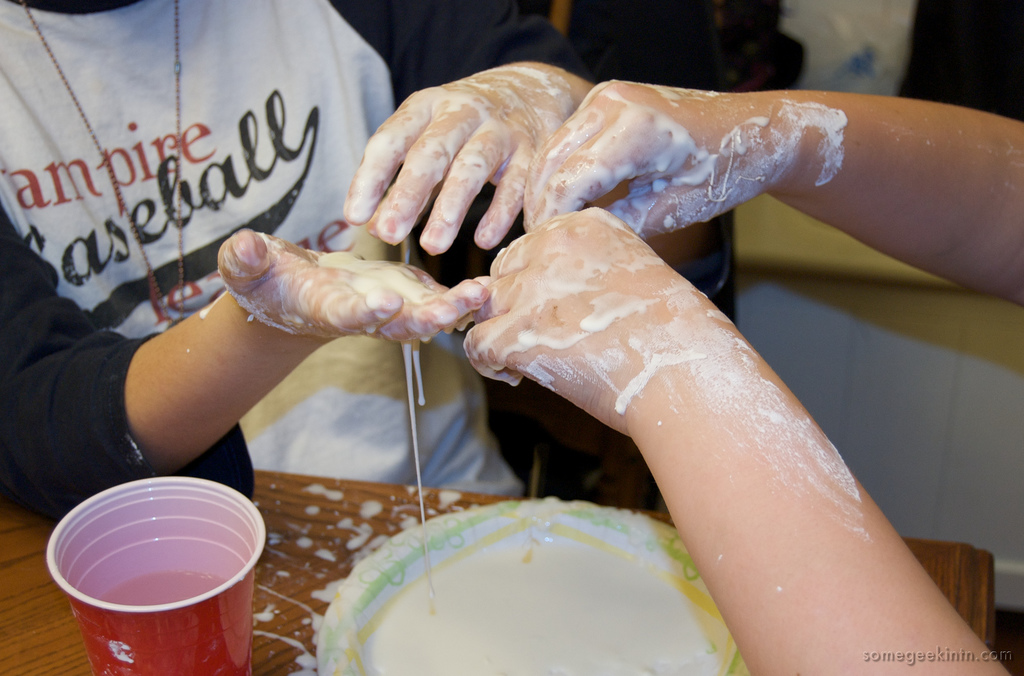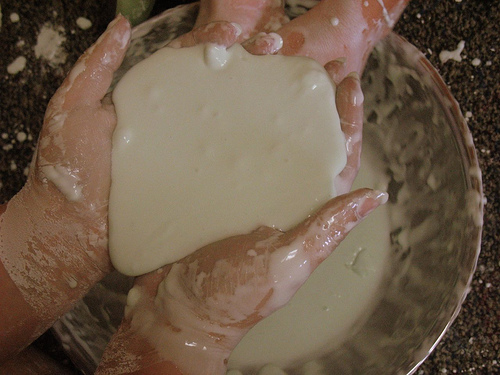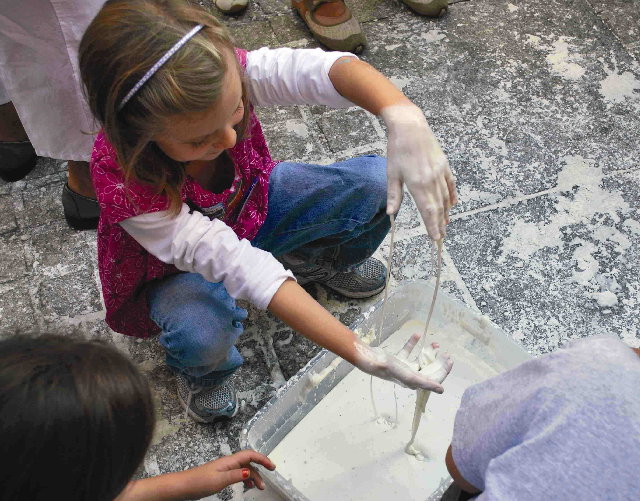Activity: Cornstarch Ooze
(Activity courtesy The Exploratorium Museum). Level: 3-8. Time Required: One class period. Recommended group size: 3-4.
Overview
This fun — but gooey! — experiment with cornstarch has students in grades 3-8 creating, then testing, a batch of cornstarch ooze. They learn about the unusual properties of this and other non-Newtonian fluids.
Background
The cornstarch ooze is made up of tiny, solid particles of cornstarch suspended in water, a mixture chemists call a colloid.
As students will discover when they experiment with ooze, it does not behave like most familiar liquids. Smack water with a spoon and it splashes. Smack Ooze with a spoon and it acts like a solid. When banged with a spoon or quickly squeezed, it freezes in place. The harder you push, the thicker the ooze becomes. But when the students open their hands and release the mixture, it will drip like a liquid. Try stirring quickly with a finger, and it will resist the movement. Stir it slowly, and it will flow around your finger easily.
Most liquids don’t act like that. If you stir a cup of water with your finger, the water moves out of the way easily — and it doesn’t matter whether you stir it quickly or slowly.
Your finger is applying what a physicist would call a sideways shearing force to the water. In response, the water shears, or moves out of the way. The unusual behavior of the ooze relates to its viscosity, or resistance to flow. Water’s viscosity doesn’t change when you apply a shearing force — but the viscosity of your ooze does.
Back in the 1700s, Isaac Newton identified the properties of an ideal liquid. Water and other liquids that have the properties that Newton identifies are call Newtonian fluids. Ooze, which doesn’t act like Newton’s ideal fluid, is classified as a non-Newtonian fluid.
There are many other non-Newtonian fluids. They don’t all behave like ooze, but each is curious in its own way. Ketchup, for example, is a non-Newtonian fluid. (The scientific term for this type of non-Newtonian fluid is thixotropic. That comes from the Greek words thixis, which means “the act of handling” and trope, meaning “change.”) Physicists say the best way to get ketchup to flow is to turn the bottle over and be patient. Smacking the bottom of the bottle actually slows the ketchup down.
Quicksand is a non-Newtonian fluid that acts more like cornstarch ooze — it gets more viscous when you apply a shearing force. Should you ever find yourself sinking in a pool of quicksand (or a vat of cornstarch and water), try swimming toward the shore very slowly. The slower you move, the less the quicksand or cornstarch will resist your movement.
Materials
for each group of 3-4 students
- ample supplies of newspaper
- measuring cups or jars to contain the water
- 1 cup of dry cornstarch
- 1/2 cup of water
- a large bowl or pan
- food coloring (optional)
- small plastic toy (optional)
Clean-up
Cornstarch ooze may drain your sink, so it is better to dispose of it in a trash can or plastic trash bag. Wash all utensils — and hands — with plenty of water to dilute the compound. Any remaining traces of the ooze will eventually dry and then can be easily dusted off clothing, surfaces, bowls, and utensils.
Procedure
Preparation: Have students cover their desks or table tops with ample newspaper to protect the surfaces. Distribute the supplies to each group.
Directions to the students:
 1. Place the cornstarch in your bowl, then take turns sifting the cornstarch through your fingers, describing its feel to one another and your teacher.
1. Place the cornstarch in your bowl, then take turns sifting the cornstarch through your fingers, describing its feel to one another and your teacher.
2. Add the water slowly, mixing the cornstarch and water with your fingers until all the powder is wet. Add a drop or two of food coloring (optional).
3. Take turns adding water until the cornstarch feels like a liquid when you’re mixing it slowly. Describe its feel – is it liquid, watery, or powdery?
4. Next, tap on the surface with your finger or a spoon. When the cornstarch ooze is just right, it won’t splash. Instead, it will feel solid. If your ooze is too powdery, add a little more water. If it’s too wet, add more cornstarch.
 5. Now it’s time to test your ooze!
5. Now it’s time to test your ooze!
- Pick up a handful and squeeze it. Stop squeezing and it will drip through your fingers.
- Rest your fingers on the surface of the ooze. Let them sink down to the bottom of the bowl. Then try to pull them out fast. What happens?
- Take a blob and roll it between your hands to make a ball. Then stop rolling. The ooze will trickle away between your fingers.
Put a small plastic toy on the surface. Does it stay there or does it sink?
Assessment
Lead students in a discussion of their findings with the ooze, encouraging them to describe the changing properties of the liquid, and allowing them to speculate on why the ooze behaves in this manner.
This activity can be used as an introduction to such concepts as viscosity, polymers, and non-Newtonian fluids.
Resources
For a similar ooze activity that provides further exploration of the science behind it, see the Oobleck experiment from North Carolina State University’s The Science House.
For more easy recipes for entertaining non-Newtonian fluids, see “Bizarre Slime,” from bizarrelabs.com.
Image credits: Stacie Harrison of ASEE, at the USA Science and Engineering Festival Expo, 2010; Casey Fleser, Oobleck, Wiki Commons; Jackie Gresham, “Oobleck,” Wiki Commons.
Filed under: Class Activities, Grades 6-8, Grades K-5
Tags: Chemistry, Class Activities, Grades 3-8, Polymers, Slime









